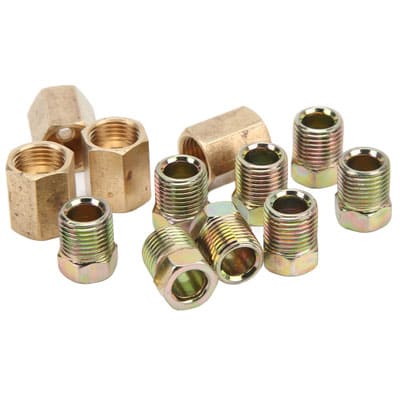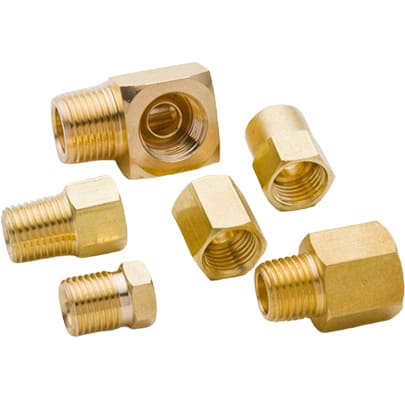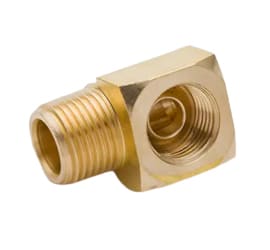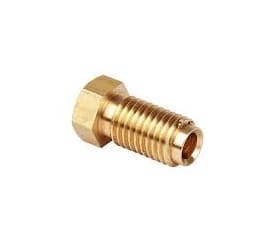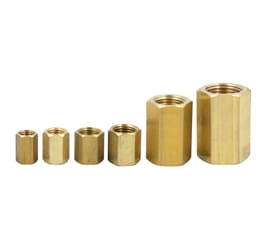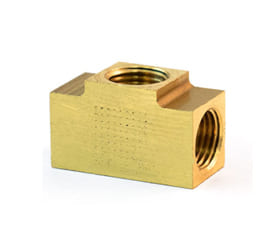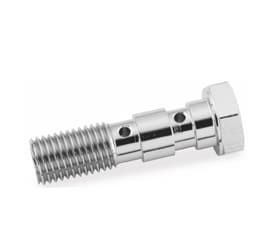Brake Line Fittings Supplier & Manufacturer USA
Brake line fittings are small parts, but they do work to keep brake systems sealed. They connect tubes, hoses, cylinders, and callipers so fluid pressure moves without leaks.
CNC turning makes these fittings precise. You will see parts like banjo bolts, flare nuts, unions, Inverted elbow, connectors, and adapters in every assembly. Common metals are brass, stainless steel, and copper-nickel.
OEM buyers stock in bulk for garages and repair shops. We support small batches to high-volume supply for the USA, Europe, Asia, and the globe.
When the fitting fails, the brake system fails. That is why accuracy and clean machining matter more than anything.
Types and Forms of Brake Line Fittings
There is no single fitting that works for all brake systems. Each design solves a different problem. Buyers usually ask for the following types:
Connection Types
Banjo Fittings
Work with banjo bolts and washers. Used when space is tight and fluid still needs to flow. Very common in motorcycles and cars.
Bulkhead Fittings
Pass through panels. They hold the brake line secure and sealed. Often ordered by OEMs.
Compression Fittings
Clamp the tube with a sleeve and ferrule. Easy to assemble and strong under pressure. Repair shops keep them in stock.
Flare Fittings
A classic connection style. The flared end seats tight against the fitting body. Reliable under high pressure.
Inverted Flare Fittings
The tube end folds inward for a stronger joint. Handles vibration well. Standard in US brake systems.
Metric Fittings
Built to international sizes. Needed for European and Asian vehicles.
Bubble Flare Fittings
These have a rounded flare at the tube end. If you work with European cars, you will see them all the time.
Union Fittings
A small part that does an important job, joining two brake lines together.
Tube Nut Fittings
Threaded nuts that hold the tube in place.
Fitting Forms
Elbow Fittings
Instead of bending the tube, you just drop in an elbow. A clean 90-degree turn, perfect when space is tight.
Tee Fittings
One line in, two lines out. You will find these in trucks, trailers, and heavy equipment.
Four-Way Fittings
When a system needs multiple outlets, this is the block that does the job. Common in buses and industrial brake setups.
Connectors and Couplings
These link tubes of different lengths or materials.
Adapters
Not all systems match. Adapters solve that by changing thread type or tube size. Always needed in mixed repair work.
Banjo Bolts
Hollow bolts that work with banjo fittings and crush washers. A common sight in hydraulic brake lines.
Plugs
A simple part that seals an unused port. Sold in packs of dozens or hundreds.
Nuts
Standard hex nuts for fittings. Basic, but you cannot assemble a system without them.
Couplers
Mostly used in hydraulic or pneumatic sections. They give a quick way to connect or disconnect lines.
Materials and Finishes
Not all fittings are built from the same metal. The choice depends on pressure, cost, and where the vehicle runs.
Steel
Strong and low cost. Handles pressure well. Most OEM fittings are made from steel.
Stainless Steel
The premium choice. Resists corrosion even in marine conditions. More expensive, but service life is much longer.
Brass
Easy to machine and gives a reliable seal. Common for compression and inverted flare fittings.
Copper-Nickel (CuNi)
Soft enough to bend easily, tough enough to resist salt and rust. Very popular in Europe for brake lines.
Aluminum
Lightweight. Mostly used for specialty applications, not heavy-duty brakes.
Finishes and Coatings
Zinc Plated
The everyday option. Clear and yellow finish, affordable, and protective.
Nickel Plated
A step up from zinc. Extra corrosion resistance and a cleaner look.
Chrome Plated
High shine, almost decorative. Used on motorcycles and custom builds.
Black Oxide
A matte finish that avoids glare. Often chosen for military or off-road use.
Anodized Aluminum
Strengthens the surface and opens up color options. Works only on aluminum fittings.
Applications of Brake Line Fittings
Brake line fittings are mainly used in the automotive world. Cars, trucks, buses, and motorcycles all rely on them to carry brake fluid safely under pressure. Racing and performance vehicles use stronger stainless or plated versions for safety at high speeds. Heavy trucks and buses need larger fittings for stronger braking systems. Off-road vehicles and 4x4 builds also use them, where vibration and dust make durability important.
Brake line fittings are mainly used in the automotive. Cars, trucks, buses, and motorcycles all rely on them. Racing and performance vehicles use stronger stainless version for safety. Heavy trucks and buses need larger fittings for stronger braking system.
Production Capacity & Bulk Supply
We handle small runs as well as high-volume supply for OEMs, distributors, and manufacturers worldwide.
| Item | Details |
|---|---|
| MOQ | 1000–2000 pcs depending on fitting type |
| Monthly Capacity | 50,000+ pcs |
| Materials | Steel, Stainless Steel, Brass, Copper-Nickel, Aluminum |
| Lead Time | 3–5 weeks for bulk orders |
| Packaging | Export cartons, bulk packs, and custom labelling as per requirements |
| Shipping | USA, Europe, Asia, Middle East – by sea and air |
Comparison Table – Materials for Brake Line Fittings
| Material | Strength & Pressure | Corrosion Resistance | Cost Level | Common Use Cases |
|---|---|---|---|---|
| Steel | High strength, handles high pressure | Needs coating for rust protection | Low | OEM brake lines, trucks, buses |
| Stainless Steel | Very high, durable under stress | Excellent, resists rust in any climate | High | Racing, marine, premium vehicles |
| Brass | Medium strength | Good, seals well | Medium | Inverted flare, compression fittings |
| Copper-Nickel (CuNi) | Medium, flexible and easy to bend | Excellent, road salt resistant | Medium-High | Europe market, replacement brake lines |
| Aluminum | Light but lower strength | Depends on anodizing | Medium | Specialty, lightweight builds, motorcycles |
FAQs – Brake Line Fittings
1. Can I order brake line fittings in mixed types and sizes?
Yes. Most bulk buyers order assorted fittings such as unions, tees, elbows, and nuts in the same shipment.
2. What is the minimum order quantity (MOQ)?
MOQ starts at 500–1000 pieces depending on fitting type and material.
3. Do you supply custom brake line fittings?
Yes, fittings can be made to drawing or sample. Buyers often request custom threads, sizes, and coatings.
4. How fast is delivery for bulk orders?
Standard lead time is 3–5 weeks for bulk runs, depending on order volume.
5. Do you offer surface finishes?
Yes. Options include zinc plating, nickel plating, chrome, black oxide, and anodizing for aluminum.
6. Can you export worldwide?
Yes. We regularly ship to the USA, Europe, Asia, and the Middle East.
7. How can I request a price quote?
You can send your product technical drawings. We will prepare a quotation.
Final Words
We focus on what buyers need most: consistent quality, reliable supply, and timely delivery. Whether you need thousands or bulk quantities, we are ready to support your orders.
Get a Free Brake Line Fittings Quote – Send your product list or drawing today.